How to make quick and easy authentic kimchi – In just 30 minutes of hands-on-time you’ll have a deliciously spicy (but not too spicy!), gut-healing and probiotic-filled condiment to enjoy with all your Korean favorites!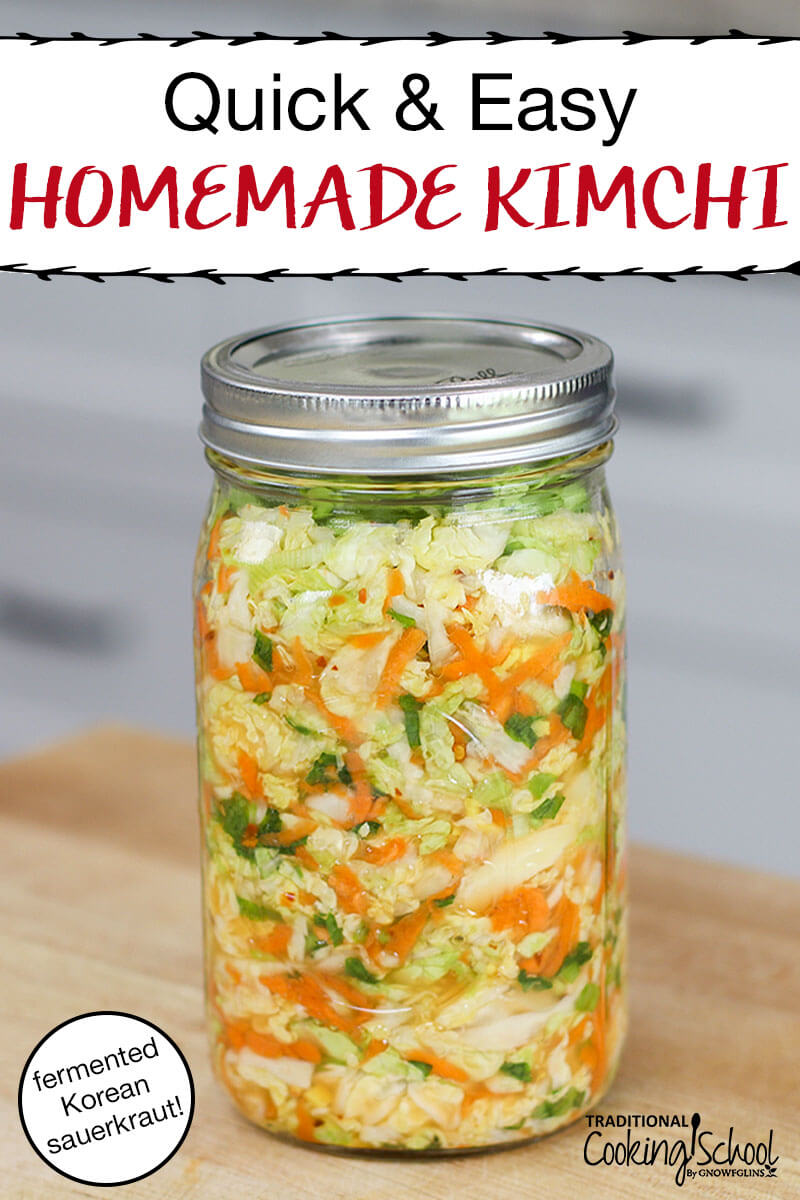
My family surprised me by liking traditional, lacto-fermented sauerkraut — the straight-up kind as taught in our lacto-fermentation class on Traditional Cooking School. They’re surprising me with their love for the two variations: homemade kimchi (or kimchee), the Korean sauerkraut; and homemade tsukemono, the Japanese sauerkraut.
Table Of Contents
What is Kimchi?
Kimchi is a fermented side made from vegetables and spices. There are so many varieties of Kimchi, however most Americans are familiar with the variety made with napa cabbage and spices such as Korean chili powder or red pepper flakes. Oftentimes you’ll find kimchi with veggies like garlic, ginger, onion and daikon radish. If you’re not sure you like Kimchi, many grocery stores are now carrying naturally fermented kimchi in a glass jar. If your local store doesn’t carry it, check out an Asian Market as they’re sure to have some.
Kimchi makes a fantastic snack. It’s low-carb and filled with gut-healing probiotics. It also compliments soaked brown rice well as a flavorful topping to an otherwise bland side dish.
Growing up, I didn’t like kimchi too much. Probably because of the red chili in it. I much prefer sour over spicy, any day! Yet, the heat is growing on me. And I like my own homemade kimchi recipe. It is not too spicy and I love how good it is for us, if made traditionally using lacto-fermentation.
I like my kimchi with both bigger pieces of hand-chopped cabbage or smaller, more evenly chopped pieces from a food processor. Both methods are fine, but you will get a quicker fermentation and more even texture using a food processor. You decide which you want to do — both are good.
Many people wonder if you can make a vegetarian kimchi or a spicy Kimchi recipe without seafood ingredients (like salted shrimp). Yes, you can! And this recipe is perfect; just increase the chili flakes to your spice preference.
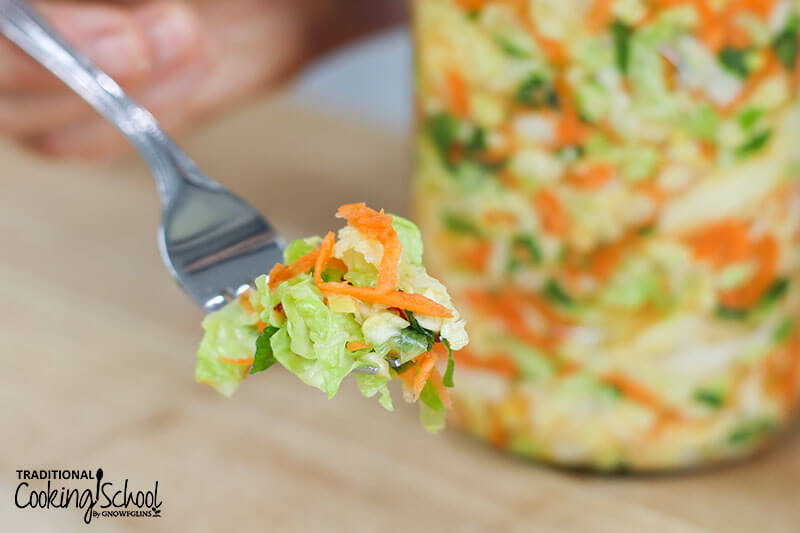
Is Kimchi Good for You? – Health Benefits of Kimchi
- Kimchi was named one of the World’s Top 5 Healthiest Foods by Health Magazine in 2017.
- Kimchi is high in dietary fiber as well as Vitamin A, Vitamin B and Vitamin C.
- Kimchi is rich in probiotics which can help aid in a healthy gut microbiome.
- Kimchi is low fat and low carb.
- It’s said that Kimchi is what helps Koreans avoid obesity because of it’s satisfying nature while being so low in calories. Many Koreans eat kimchi at least once daily, oftentimes with each meal.
The kimchi recipe that I’m sharing today is an adaptation of the recipe in Nourishing Traditions on page 94. It’s filled with healthy probiotics (as most ferments are) and the longer you let it ferment the deeper the flavors will become and there will be a higher probiotic content.
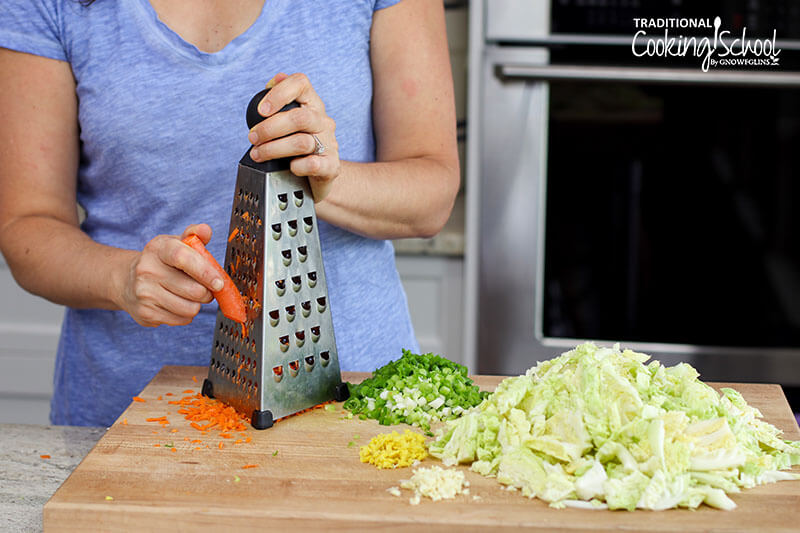
How you make your Kimchi is entirely up to you. Because there are so many vegetables that can be fermented, you can mix in or omit different veggies as you see fit. Many veggies range in flavor from mild and mellow to quite strong and extremely spicy. I suggest you experiment with your veggies until you find the perfect combination that’s to your liking.
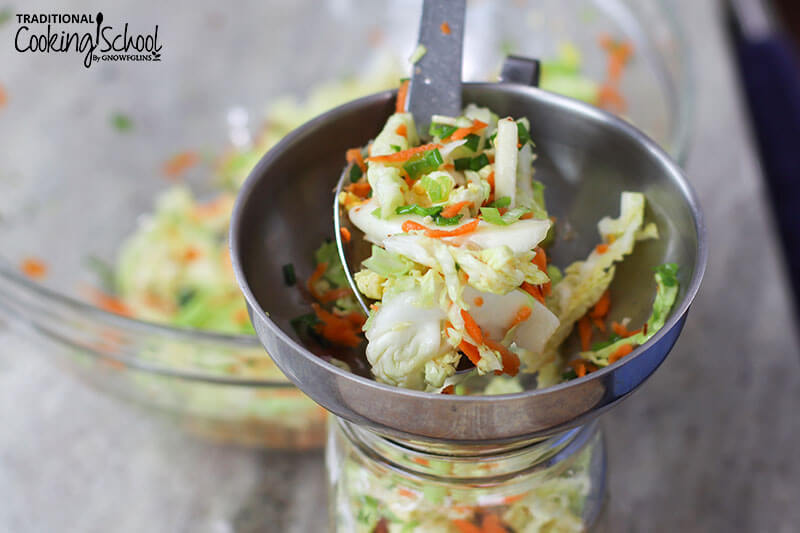
Do I Need Special Tools To Make Kimchi?
In short, no! Making ferments is one of the easiest things to do in a real food kitchen. A simple mason jar and lid will do. It’s important to understand a few basic principles when fermenting, which is why I recommend my Lacto Fermentation course.
While I say there are no special tools needed for fermenting, there are definitely tools that will help get the job done easier. Some of my favorites are as follows:
- Prepper Pro kraut pounder from Homesteader Supply – this really helps to push and press the kraut into your jars and under the liquid to get all the excess air out.
- Pickle Pro airlock lids – these lids are wonderful for using a mason jar. They let air out without letting air in.
- Fermenting Airlock – This airlock system works well with the Fermented Vegetable Master from Cultures for Health.
- Fermenting Weights – These weights are the perfect item to help hold all veggies under the water and reduce the potential for mold.
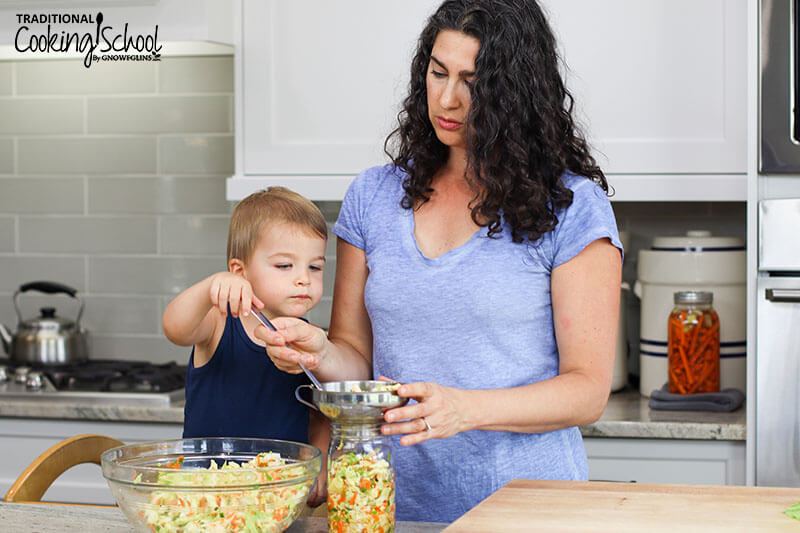
How is Kimchi Made? The Fermentation Process
My favorite method for making kimchi or sauerkraut is my no-pound method (try this simple, no-pound sauerkraut). Essentially, you salt the veggies and let it sit for 30 minutes to naturally draw out the water within the veggies. This keeps you from having to pound by hand to release the juices. I find this not only saves time, but so much strength!
Another reason I love this recipe so much is that it doesn’t use fish sauce. Though I’m not against using fish sauce, I just find the smell to be overpowering at the beginning and have found I’m happy with this recipe without it. If you’d like to try adding a bit, you can pick some up at most Korean Markets (though you could likely sub in a bit of soy sauce as well).
The basic fermentation process is like this:
- Prep your fruit or veggies.
- Add mineral-rich salt to draw out natural liquids.
- Put into a clean jar or crock.
- Let sit at room temperature.
- Eat & enjoy!
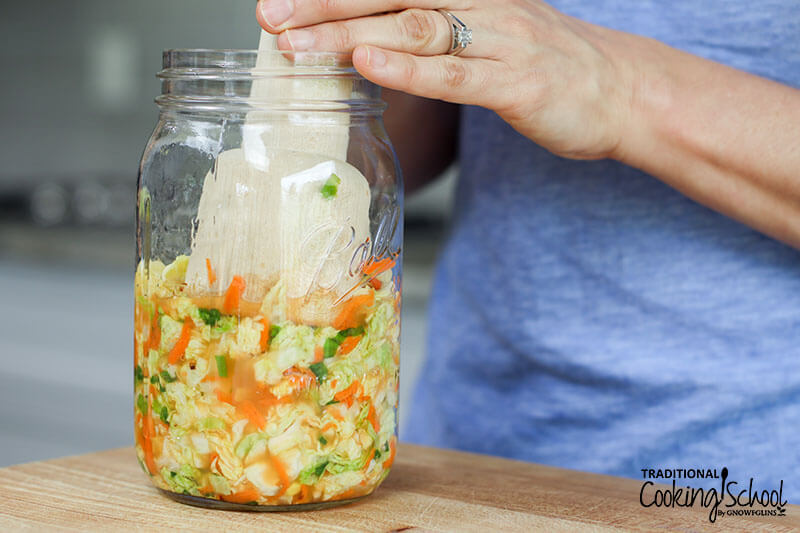
Kimchi FAQs:
There are a lot of questions about fermenting foods and we hope Traditional Cooking School can be your one-stop blog to find all your answers. If you don’t find the answer to your question here, or in one of the additional articles listed below, feel free to add your question in the comments!
How long does sauerkraut keep in the fridge once opened? Does kimchi go bad?
If Kimchi is stored properly it has quite a long shelf-life. As long as you’re creating your kimchi with clean utensils and properly re-packing the kimchi so all the vegetables are under the brine each time you open the jar, it should last indefinitely. It’s important to note that the texture and flavor will continue to change the longer it sets. Some people don’t care for kimchi after a few months as the cabbage can become too soft or mushy. Others prefer it older because the flavors mellow and meld with time. It’s really all a matter of your preference, though.
How long can kimchi be safely stored un-refrigerated?
Kimchi should only be left un-refrigerated during the fermentation stage (usually between 3 to 14 days, give or take and depending on the size/thickness of your veggies). Once the kimchi has reached your desired flavor, it’s best to transfer it to cold storage or the refrigerator. Cold storage should be between 32 and 50 degrees Fahrenheit for best results.
What happens if I put kimchi in the fridge while fermenting?
Sometimes life happens and we need to hit “pause” on our ferments. Even if your kimchi hasn’t quite finished fermenting, you can place it in the refrigerator for a few days to take a break or make sure it doesn’t ferment beyond your liking. Once you’re ready, bring the kimchi back to room temperature to continue the fermenting process.
How to get rid of kimchi smell in my fridge?
I’ve never had my refrigerator get smelly due to a ferment, but as I mentioned above, I do leave out the fish sauce. If you have an unfortunate spill or your lid isn’t sealed tight, there’s a chance your fridge may have some off smells. If you’ve spilled, be sure all liquid and any food pieces are cleaned and sanitized properly. If smell still remains simply place a bowl of baking soda in the refrigerator overnight (or up to a week) until the smell is completely gone.
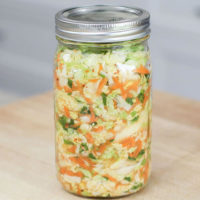
Homemade Kimchi: An Easy Korean Sauerkraut Recipe
Kimchi is a classic Korean sauerkraut that has a spicy kick. This easy homemade recipe is a bit more mild, takes just 15 minutes of hands-on time and has many benefits from probiotics formed through lacto-fermentation.
Ingredients
- 1 head Napa cabbage or savoy cabbage, cored and shredded
- 1 bunch green onions chopped
- 1 cup carrots shredded
- 1 tablespoon ginger fresh, grated
- 3 cloves garlic crushed
- 1/2 teaspoon dried chili flakes
- 1-1/2 teaspoons sea salt
- 1/4 cup plus 1 tablespoon whey *
Instructions
-
Start by chopping or shredding the cabbage, carrots, green onions, ginger and garlic by hand or with a food processor.
-
Combine all ingredients in a medium or large bowl.
-
Cover with a tea towel and let sit at room temperature for 1/2 hour while the salt helps pull the juices out of the veggies.
-
Pound a few times with a potato masher or meat hammer (or kraut pounder) to make sure it is getting juicy. If it doesn’t look wet enough, leave for another 1/2 hour. If you’re seeing plenty of liquid, proceed to the next step.
-
Transfer ingredients to a clean quart-size, wide mouth jar, leaving 1" space at the top of the jar.
-
Press down firmly. Ideally, liquid will come up to the top of the mixture, but it's ok if it doesn't at this point.
-
Add weights, if using, and put on lid and band and screw tightly.
-
Allow the kimchi to ferment at room temperature for three to seven days.
-
After 12-24 hours, open the jar and press down firmly on the ingredients a few times to make sure the brine is fully covering the mixture.
-
Brine will continue to be released over time.
-
Fermentation may proceed faster at very warm temperatures.
-
Be sure to burp jar daily to prevent air buildup. Also, if you notice air bubbles in the mixture, open the jar and press the mixture back down to submerge it all in brine again. I like to keep the jar on a towel or in a tray to catch seeping liquids.
-
Skim off any mold or fuzz that develops on top (everything beneath the brine should be fine).
-
After a few days, the mixture will be bubbly and the vegetables will soften.
-
Taste every few days and stop the fermentation when you like the flavor and texture. (We like ours best at 5 to 7 days.)
-
Transfer to the refrigerator or cool storage.
Recipe Notes
Serve alongside main dish chicken, turkey, beef, or ham. Make incredible Kimchi fried rice or even serve with eggs for breakfast. Enjoy!
- *Or omit whey and increase salt by 1/2 tablespoon.
- Repack carefully each time you serve to make sure all veggies are under the brine.
- Kimchi will keep for several months or more in the refrigerator.
- Cold storage is ideally between 32-40 degrees Fahrenheit.
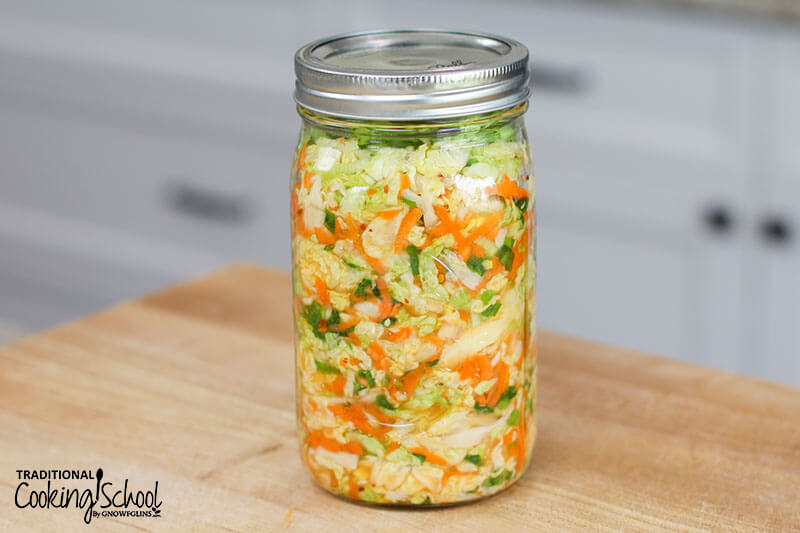
Additional Fermenting Articles
- Troubleshooting Your Ferments (KYF172)
- Lacto-Fermentation 101 Video Series
- 7 Fermenting Mistakes You Might Be Making
- Which Water is Best for Fermenting?
- Which Kind of Salt Should I Use for Fermenting?
- Can I Use Alternative Sweeteners in Ferments?
Other Fermented Condiments
- 3 Lacto-Fermented Mustard Recipes (zippy, zingy flavor!)
- Lacto-Fermented Homemade Ketchup
- Lacto-Fermented Mayonnaise
- Homemade Sauerkraut In A Stoneware Crock
- Old-Fashioned, Crunchy, Fermented Garlic-Dill Pickles
- Lacto-Fermented Turnips & Beets
Have you made homemade kimchi before? Do you like it? What’s your favorite variation of sauerkraut?
This post was featured in 43 Fermented & Probiotic-Filled Condiments.
We only recommend products and services we wholeheartedly endorse. This post may contain special links through which we earn a small commission if you make a purchase (though your price is the same).


Looks good. I don’t have any ginger, wonder if I could put in a little ginger seasoning? I’ve been to the store 2 times this week and that is probably 1 time to many!!
Also Wardee I made your soaked pumpkin bread this morning and my house smells so good. I used a sweet potato that I had not cooked at Christmas. For my husband I’m doing the whole wheat slow. I used 1 cup unbleached flour and 1 cup white whole wheat. Maybe I’ll post a picture next tuesday
Blessings Erin
I love kimchi, the kind I eat is a spicy blend, I’ve only tried this one. Fab Ferments, it is a local company in Cincinnati. My family can’t stand the smell. My husband is freaked out by the “fermentation”. I wish I could get them to jump on board with it. Mold and fuzz would make me nervous, I would have to throw it out. How do you know it is safe to consume? I’m very much looking forward to your dairy features, but then again my husband is freaked out about raw milk. Louis Pature comes up every time. Any advice?
Ironically, I just finished my jar of fab ferments kimchi yesterday, which I’d picked up at the WAPF conference where they were a vendor. Good stuff, I love the bit of spice as it causes my to enjoy the jar slowly instead of wolfing it down. 🙂
Find one of the books on raw milk and read about the history of pasteurization and share that with your husband. My husband is a confident raw milk drinker now after I read portions of The Story of Milk to him.
Thank you Trina!
What is WAPF? Fab Ferments is local to me. Are you in Northern Kentucky, Greater Cincinnati?
I’ll check out The Story of Milk. Thank you!
WAPF is the Weston A Price Foundation. They have a website, you should look it up.
Ok, I am going to make this. I’ve never had it before, but I love both sour AND spicy, so I should enjoy this.
Could you explain what you mean by “repack carefully each time you serve”?
Thanks Wardee!
Shyla — Great question! Just press all the mixture down into the jar as tightly as you can, so the brine will cover it all and protect the fermenting mixture from spoiling.
I have tried fermentation before, and I had a HUGE mold problem. I even bought the supplies and a culture starter from Cultures for Health because I thought that would help. I live in CA’s Central Valley, where mold grows very easily. Do you often have mold at the top like that? How do you know you are not exposing yourself to mycotoxins?
Brandy — I get mold in the summer when it is very hot. Any room temp over 80 degrees for me. I just skim off the top daily and pack everything down tightly — so everything is under the protection of the brine, which is rich with beneficial organisms and lactic acid to suppress harmful organisms. This fermentation, a facet of God’s design for our world, has been done for centuries, supporting the health of countless people. Sure there is a risk — but I think the risk is greater in pasteurized, denatured foods where beneficial organisms are not present to keep the bad ones in check.
Hi Brandy,
You might try using a pickl-it jar – that really keeps the whole ferment airtight and has an airlock to let the CO2 out – but nothing can get in and spoil your ferment once you seal it. It also has a great little glass disk called a dunk-it to keep your veggies submerged….very affordable.
I have replaced my mason jars with this – and it is so much easier to deal with – no exploding kraut anymore and the smell is also contained. I’ve been offering it to my workshop participants and they have been thrilled with it – most have come back to order more – way more affordable and reliable that a harsch crock.
Lisa
I made kimchi using Sandor Katz’s recipe in Wild Fermentation. My family and I tried it and thought, “Well, that’s ok, but what on earth would we eat it with?” Then we tried it again, then before we knew it we were saying things like, “I think our scrambled eggs would be wonderful with kimchi” or “Wow, we’re eating toast, let’s have some kimchi with that!” and before we knew it our batch of kimchi was all gone, and we were longing for more. It’s strangely addictive.
Katz also helped me solve my mold on the top problem. I put the veggies and liquid in a wide mouth mason jar and then put a small 8oz. jar with water, which pushes the veggies under the brine. I hope that helps!
Funny, I was just thinking about making some the other day! 🙂
Funny, I keep hearing about kimchi from my family lately! They recently moved to Korea, and tell me that the Koreans have kimchi with literally every meal — just as Nourishing Traditions recommends. My younger siblings love to try it, even though they don’t all like the spice.
Gotta try making it sometime. I just finished my first jar of regular sauerkraut and it was delicious!
I was thinking of buying a case of kimchee through my co-op, but I’ll try your recipe instead! Thanks Wardee 🙂
I’ve wanted to try making it, but I fear we are greatly spoiled by the real thing! We have some friends in So. Korea who actually send us homemade kimchi..pretty authentic! It is very spicy, but delicious. They leave the napa cabbage in large pieces, and the last batch had daikon radish in it, which was very nice! We love kimchi, and eat it with rice for breakfast (don’t tell our friends). 🙂 We have Korean supermarkets in our city so we go there for good kimchi as well. But I still would love to try to make it at home. It’s pretty smelly stuff, tho!
we love kimchi! the last time i made it i was feel’in crazy(as i usually do when fermenting food) and i added diced apples. it was still great. i used regular cabbage and no hot pepper.to the lady whos husband is suspicious, the untold story of raw milk is a great book! we loved it and its not at all boring(if you like relevant history)the mold thing isn’t a problem for me but if anything look funky, i simply remove the top layer and add more saltwater to cover it better and keep it in the fridge. thank you for the great info on this site! i love it! i made the choc sourdough cake the other day and it was amazing!
I have tried lacto fermentation a couple of times, but the veggies seem to get soggy. Is there such a thing as crisp lacto fermented food?
try putting an grape leaf in with your fermented veggies. i’ve also heard oak leaves but i have not tried this. with kraut and kimchi if you make the pieces bigger they are less soggy:)
I started a batch today. My daughter and I loved the smell of the fresh grated ginger so much that we put extra in. It has some serious heat to it! Oops, I may have gone overboard. Is this used like a condiment or a side dish? What do you serve it with? Mine smells like Chinese food so I’m thinking stir fry or egg rolls.
Pam
I just looked up something on the internet that looks good. It’s kimchi fied rice. Will stir frying the kimchi with rice and eggs kill the probiotic benefits Wardee?
Kimchi is one of the few ferments I have had good luck with and my family liked! I might need to make some when I get more jars.
It’s pretty smelly stuff, tho! Thanks Wardee!
Yeah for kimchi! I was so happy when I read this! My husband and I are Americans living in S. Korea right now, so we eat kimchi 5 times a week and sometimes more. My husband really likes the cucumber kimchi and radish kimchi (I think Korean radish is different than American radish). I am really hoping that we can find authentic kimchi once we move back (or maybe I will have to try this recipe and see if I can make my own.)
Wow…I have been trying to find more recipes for sauerkraut as I just love it. This looks so easy to make and very healthy to eat to. I’m definitely going to give this a try…!! Now, I wonder how chicken and sauerkraut mix together….every try that? Thanks…
If I don’t have any whey or starter culture, how much sea salt would I need to use instead? Would I need to add any purified water? Looking forward to trying this!
Donna — Double the salt if you don’t have the whey or starter culture. If the mixture isn’t juicy enough, top off the jar with a little water (unchlorinated and unfluoridated is best — so if that’s filtered for you, then yes).
My husband lived with a couple of Koreans his college years. He loved all the food they brought back with them from their spring breaks, and kimchi was one of them. My daughters wanted me to make kimchi because of all the Korean dramas they like to watch. The first time I did, all of them loved it, and my husband said it tasted just like what his roommates had. With the basic ingredients of garlic, hot pepper and ginger, it’s hard to get it wrong. Now we eat it with everything and anything. It’s especially good with sharp cheddar and crackers or with a hard boiled egg. I often plan dinner around what will go with the kimchi. Cortido is the South American variation of sauerkraut. I like it better because it calls for more variety of vegetables and herbs. But that might just be the Spanish in me. 😉
Hi.
I made sauerkraut and it is finished. I added water to it to make sure it was covered. Now I am not sure if I should pour off some of the liquid to store it in the fridge or leave it until eaten and then pour off? Thanks
I have been drying Italian prunes for many years. My home made dryer does not go much over 110 degrees so I rotate the trays top to bottom a few times. Then i freeze them. I”ve had some in the freezer for several years and they still cook up just like fresh.
Mostly I stew them with a little sugar and eat them for breakfast.
There are lots of different types of “kimchi”. I grew up eating various types and they all have their merits. If you are unsure about them, try going to a Korean store and get a couple of different types in small containers.
Is this going to have that same typical red color that kimchi has usually? I think alot of recipes include some sort of red pepper powder to color the kimchi – this has red pepper flakes but I think that is just for heat! Thank you for sharing this recipe, I am always excited to try making different variations of kimchi at home.
To stop the fermentation, all you need to do is put it in the refrigerator as is?
Hi Shannon,
Putting your ferments in the refrigerator doesn’t “stop” the process but it slows it down to a crawl. 🙂
~Danielle, TCS Customer Success Team
Funny you should post this the day after I see a cabbage shredder at Farm and Fleet. Think a mandoline on the scale of a head of cabbage! Search Slaw Board and Cabbage Shredder on your favorite search engine.
Was nervous about starting my own fermented vegetables – now a convert thanks to your delicious kimchi recipe. I have eaten kimchi many times for the health benefits & enjoyed it up to a point. Making my first batch & allowing the flavor to develop to my own taste was a game changer. Looking forward to the fermenting broccoli, cauli and onion ferment to add our meals as well. Thank you so much!
Hi, I have a suggestion for y’all- use purple cabbage either with or instead of white cabbage. First off it contains bioflavinoids and second, it shows you when it’s safe to eat.
Purple cabbage changes color depending on the pH it’s in. When the pH drops (becomes more acid) the cabbage and brine turn a deep red. Your Kimchi will be tangy from that point forward.
When you stop is a matter of trial and error, especially if you use starter culture as I do. The results are more predictable and WAY faster. I also can use less salt that way. I can make a 1/2 gallon of Kimchi in 3 weeks with 1 starter culture or 1-1/2 weeks with 2 starters.
The recipes was perfect!
Thank you.
Hi, Jalal,
You are very welcome. I am happy you liked it! 🙂
~Peggy, TCS Customer Success Team
This cannot be called Kimchi.
Hi, Jack,
There are many different versions of kimchi and this version is what Wardee loves to make. 🙂
~Peggy, TCS Customer Success Team
Is there a non-dairy substitute for the whey?
Hi, Lana,
In the recipe notes it states: *Or omit whey and increase salt by 1/2 tablespoon.
You can also use kombucha or water kefir as a live culture.
~Peggy, TCS Customer Success Team
Thank you so much! I am sorry I missed that.
No worries, happy to help. 🙂
What is the weight of the Napa cabbage used? I used an over 4# cabbage today to start sauerkraut so I doubled the salt and the carrots (so 2 med or a generous 1 cup). Saying large or medium rly are is very subjective. Weight is much better.
I use 2T salt per 2# cabbage. I find 4# fills a half gallon jar. I need to make a gallon at a time. It took me 5-6 weeks to get the 1st batch to the tangy n crispy enough level to eat. So we will run out before this batch is even near ready!
Idk how ppl only ferment for 3-14 days!!
I just saw your site on pinterest while on lunch break at work, so haven’t tried anything yet but wanted to say thank you for the info, recipes, and more. I’m just starting this and the pictures look mouthwatering. That is a mighty handsome little helper you have. I hope he learns this from you and carries on the family health.
Has anyone made this using red cabbage? I have a huge one and I’ve got red cabbage and beets fermenting now but still have leftover red cabbage.
I’ve been making kefir, kombucha, sauerkraut, etc. and only recently discovered daikon radishes, which are growing like weeds in my garden! So, I started looking for recipes and found this online and was surprised it was you that I watched on Youtube when I began my kefir journey years ago. So, good surprise! I will definitely try this recipe(or some hybrid version) and look forward to enjoying my daikon radishes fermented as well as adding crunch and punch to my ubiquitous stir fries. Thank you for the information!
I see dark green and orange vegetables in the pictured jar. The dark green – onion tops or green bell pepper? Orange…bell pepper, carrot?
Hi, MJ. The dark green is green onions, and the orange is sliced carrots. 🙂 ~Makenzie, TCS Success Team